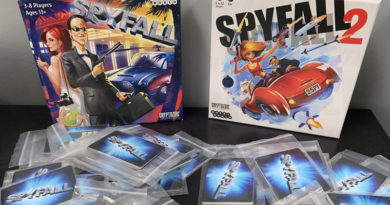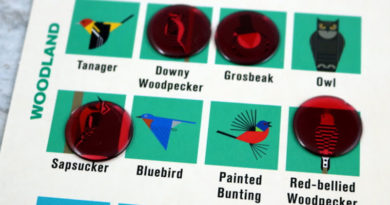The Search for Planet X deduction game review
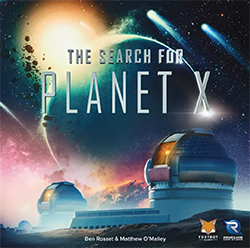
I love logic puzzles.
In fact, a number of years ago, I bought a stack of back issues of Penny Dell Logic Puzzles so I could rattle through logic puzzles during flights on business trips.
As such, I also love good deduction board games.
I enjoy thinking through various logic conditions to figure out the solution in a deduction game before the other players. And modern deduction board games have come a long way from classic Clue.
So when I heard about The Search for Planet X, by Renegade Game Studios, it caught my attention.
I got a copy of the game at SaltCon Spring 2024, and was immediately hooked from my very first play. Since then, I’ve played it with family and friends – many of who have bought a copy of their own. Yep, it’s a good one.
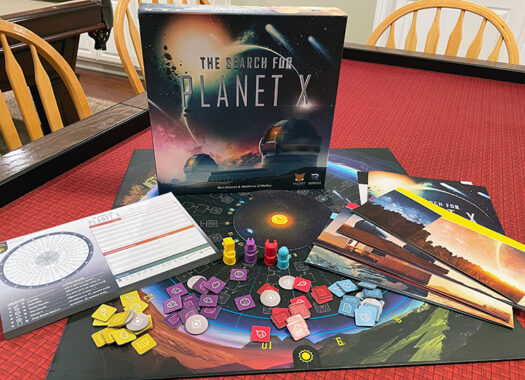
How to play The Search for Planet X
Overview
In The Search for Planet X, players are astronomers using observations and logical deductions to search for the elusive planet X. To play the game, players need to use the free companion app. Each game, the app randomly selects an arrangement of objects (asteroids, comets, gas clouds) and the location of Planet X. As players take turns, they’ll interact with the app to receive logic rules that will help them deduce the locations of these various objects.
Each player also gets a sheet to make notes and record their thoughts on where everything could be. At multiple points throughout the game, players may place theories about the objects, which is how players score points.
Once a player believes they know the location of Planet X and the objects on either side of it, they use the app to conduct a search. The game ends when a player successfully locates Planet X, and all players have a final chance to score some additional points.
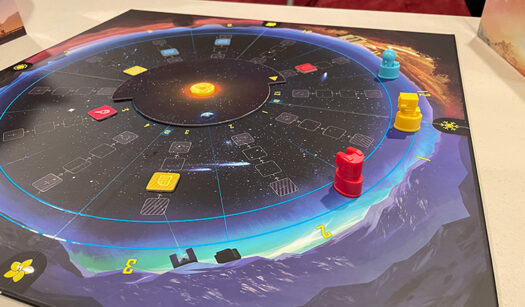
Set up
At the beginning of the game, players choose whether they’ll play the Standard or Expert mode. The Expert side of the board has more sectors and more objects. Once chosen, each player takes a note sheet in accordance with their position at the game board (Spring, Summer, Autumn, Winter). The sectors are aligned on the sheets to match the orientation of the board.
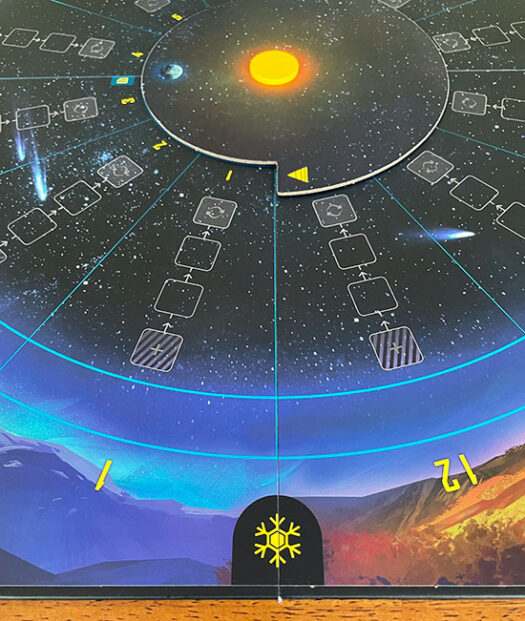
Upon initiating the game in the app, players are prompted to indicate their skill level. This determines how many starting facts they’ll receive from the app. Each player may select their own skill level: Youth gets 12 facts, Beginner gets 8, Experienced gets 4, and Genius gets 0. Players make note of these facts on their sheet.
Players take the theory tokens in their color and place them behind their player screen. They also place their pawns on the outer ring of Sector 1.

Player turns
Play does not proceed in a fixed turn order. Instead, the player whose pawn is farthest back is the active player.
On a player’s turn, they perform one of the following actions then advance their pawn based on the time cost of the action:
- Survey
- Target
- Research
- Search for Planet X
SURVEY
The player can survey any continuous group of sectors in the visible sky (the central dial covers the non-visible sector numbers as it rotates). They announce what object they’re surveying for and in which sectors. The range they survey determines their time cost (how far they move their pawn). Surveying 1, 2, or 3 sectors costs 4. Surveying 4, 5, or 6 sectors costs 3. And in Expert mode, surveying 7, 8, or 9 sectors costs 2. Essentially, the more narrow you survey, the more it will cost you in time.
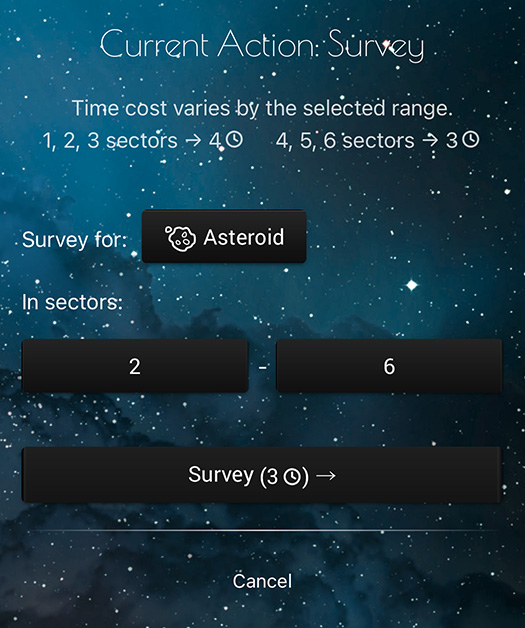
For example, if the player surveys for gas clouds from sector 2 through 5, this is a range of 4 sectors, so their time cost is 3.
After the player announces what they’re surveying for an which sectors, they enter that in the app and the app will them them how many of that object are found in that range of sectors. The player makes note of this on their sheet but does not reveal it to their opponents.
The player then moves their pawn ahead the number of sectors equal to the cost of their action.
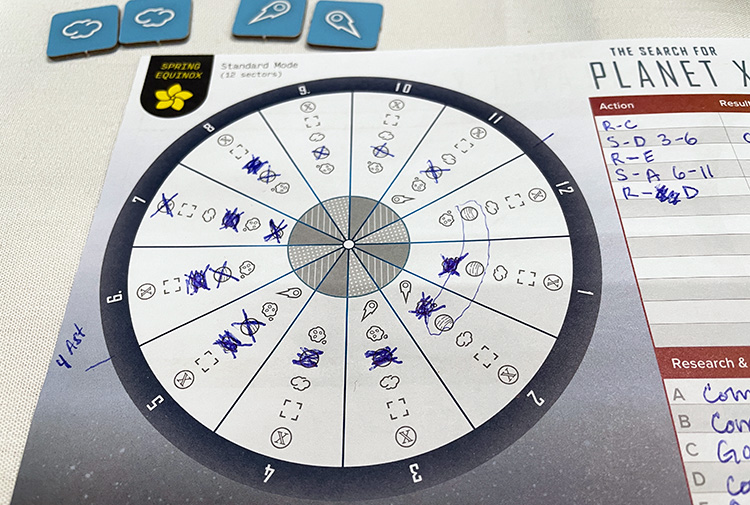
TARGET
For targeting, the player announces a single sector in the visible sky to target. They enter this into the app and the app reveals to them what object is found in that sector. Again, they write the answer on their sheet but don’t reveal it to others. Players may only perform the target action, at most, twice per game.
The time cost of this action is 4 and the player advances their pawn this many sectors.
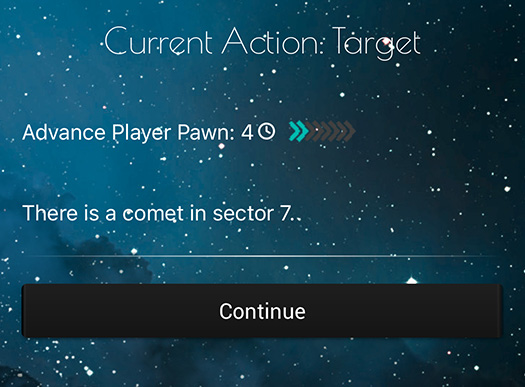
RESEARCH
When players initiate the game in the app, it will also designate the Research topics for that game. These topics are logic rules that typically indicate how the various objects relate to each other. Players make note of these topics in the Research section of their sheet.
When they take the Research action, they announce which topic they’re researching. They select that topic in the app and it reveals information about the objects researched. They make note of the information on their sheet but don’t reveal it to others. (When others research the same topic, they’ll receive the same response.)
The time cost for this action is 1. However, players may not take a Research action twice in a row. They must do another action in between.
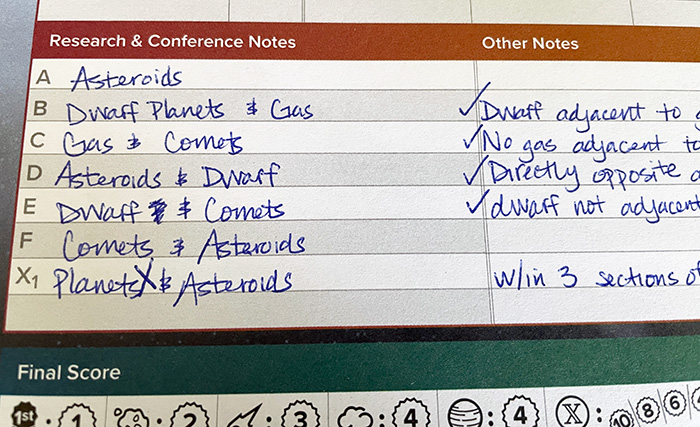
SEARCH FOR PLANET X
The final option a player has on their turn is to make a search for Planet X. The time cost for this action is 5.
To do so, they simply announce they’re searching for Planet X, but don’t say in which sector. Instead, they just enter that sector in the app. The app will also ask which object is found in each adjacent sector. The app will indicate if the player is correct or incorrect. If any of the three items is incorrect, the app will simply say incorrect. In won’t say which item or items are wrong.
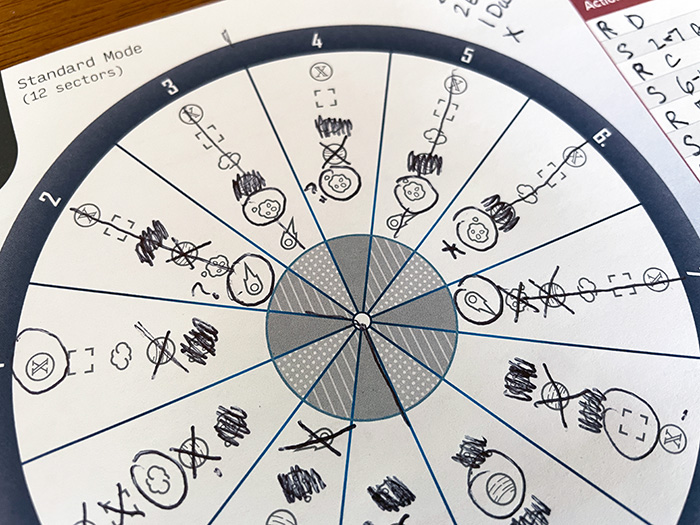
If incorrect, they move their pawn 5 spaces and play continues.
If correct, they move their pawn 5 spaces and each other player gets to either conduct a search for Planet X themselves or place additional theories for their final action.
The game then ends and players total their points. The first to correctly discover Planet X gains 10 points. Others that find Planet X get points based on how far behind they are on the time track.
Players also gain points based on their correct theories they’ve placed throughout the game. So let’s dive into how theories are placed.
Placing Theories
After a player moves their pawn, players check to see if the Earth rotates. If the arrow on the central Earth board is not pointing directly at a sector which contains the pawn that’s furthest back, players rotate the board clockwise. It moves until it catches up with the sector with the furthest back pawn. Along the way however, if it hits a point with a Theory icon on it, the game pauses for players to place theories.
Players simultaneously select a theory token they wish to submit and place it face down under their hand outside their player screen. Once all have selected (or chosen not to), players place their token face down in the outer-most square of a sector they believe contains that object.
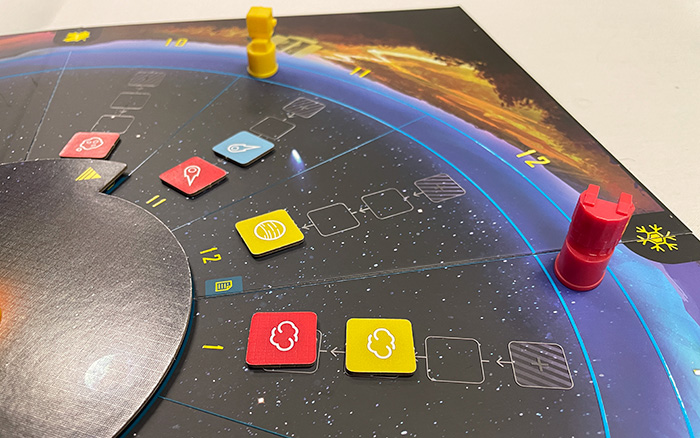
Next, all face down theory tokens are moved toward the center one space. If a token reaches the inner space, it’s time for a Peer Review. For that, players flip the token face up to reveal the object theorized. They select Peer Review in the app and indicate the sector and object. The app will reveal if that theory is correct or incorrect.
If it’s correct, all other tokens on that sector are also flipped face up. All tokens showing the correct object for that sector remain where they are. Any incorrect are removed from the game and the player that submitted an incorrect theory for that sector moves 1 sector on the time track as a penalty.
If during a Peer Review, the original token flipped to check is incorrect, all other tokens remain face down. The incorrect token is removed from the game and the player that submitted an incorrect theory for that sector moves 1 sector on the time track as a penalty.
At the end of the game, each correctly placed theory receives points indicated at the bottom of the player’s sheet. Some objects are more valuable than others.
A player who was the first to place a correct theory in a sector receives a 1 point bonus.
Game End
After a player finds Planet X and the other players have taken their final action, players total all their points (from theories and finding Planet X), and the player with the most points wins!

Can the whole family enjoy The Search for Planet X?
The Search for Planet X is a fantastic deduction game for playing with friends and family. The recommended age on the game box is 13+ and that’s pretty accurate for who’s going to enjoy this game of logical deduction.
Sure, there will still be many younger players who will be able to dive in and enjoy the game. But for the most part, teenagers and above is the target.
One way to accommodate players of all logic puzzle skill sets is through the opening choice in the game app of how many clues you start with. We like that each player can choose for themselves what level of difficulty they want to face and get an appropriate number of starting facts in the app.
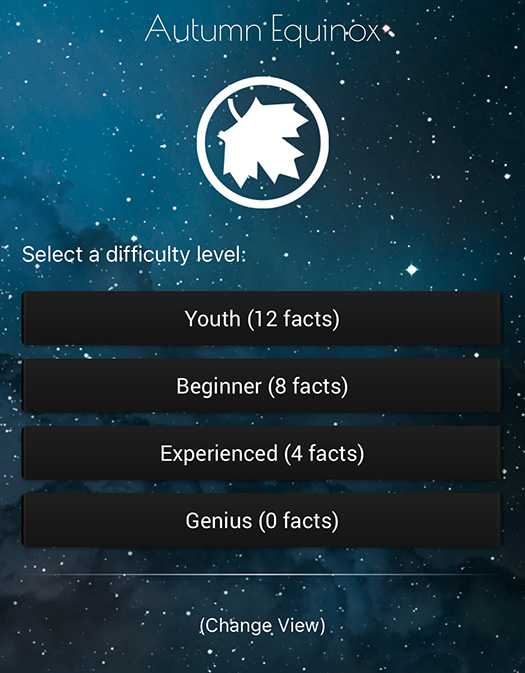
Speaking of which, the game app is fantastic. The interface may be simplistic, but we don’t need it to be anything fancy. In fact, the simpler interface, the better. That’s because the beauty of the app comes in the way it randomizes the locations of all the objects for each game. And solving that puzzle is the crux of the game. So having an app that maps it out, then spits out clues along the way is wonderful.
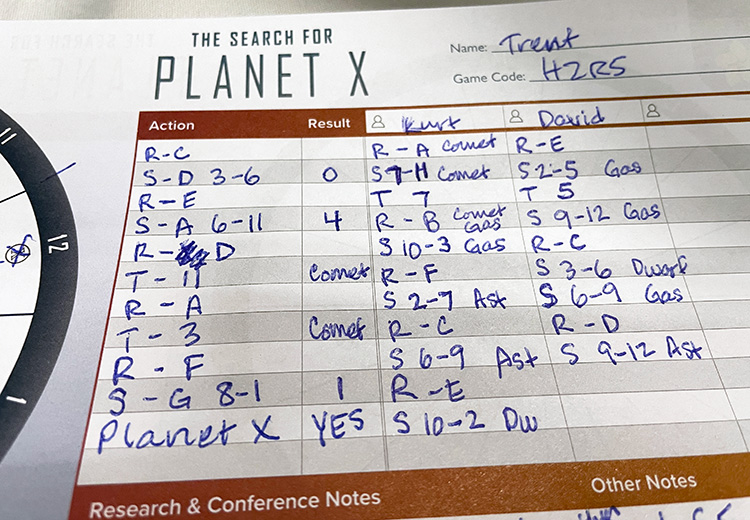
We also really like how the game flow itself presents critical choices for players. Each action you take, requires “time” (pawn movement on the board). You can get more precise information on your turn, but it will cost you more time. Which in turn will allow other players to take more turns before it’s your turn again. So you have to factor in that trade-off when choosing which action to take on your turns.
For example, taking the Research action only costs 1. So if you choose to do that while other players are further ahead on the track, you may be able to take two turns in a row. It’s pretty nice. The only catch is that you can’t take the Research action itself twice in a row. So plan out carefully what you’ll do next.
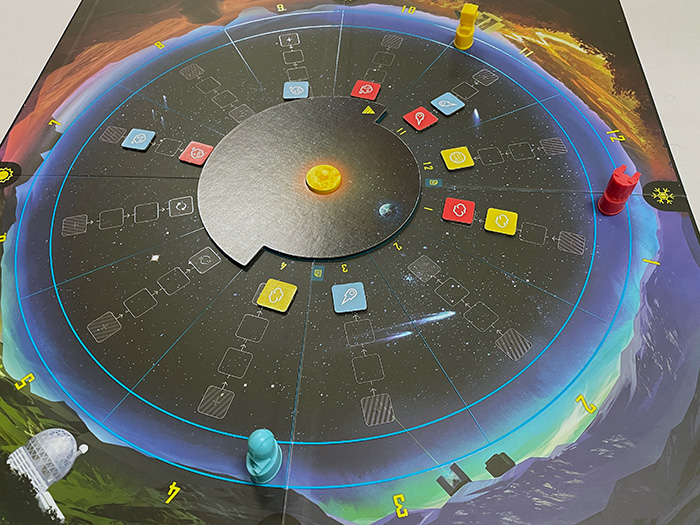
Another great element is the placing of Theories. One of the best ways to get points is to correctly guess which object is in which sector and placing the corresponding Theory in that sector. So you’ll want to place those once you’re sure of the object. And since you can get a bonus point for being the first player to properly guess that object in the sector, you’ll want to get out ahead on those Theories. However, the downside is that as soon as a Peer Review happens, your token will be revealed and all players will now know what’s in that sector. You’ll get points, but they’ll also get accurate information. So you’ll want to be strategic on when to place your Theories.
The player sheets are helpful for taking notes and allow enough space to also make note of the actions other players take. Of course, you won’t know the result of what they find out, but you may be able to deduce what they may know by what they’re searching for on their turns.
As an example, in one recent game, a player Surveyed for the Dwarf Planet in sectors 2-6 on their first turn. Then a couple of turns later, they Surveyed for the Dwarf Planet in sectors 9-12. Since there’s only 1 Dwarf Planet in Standard mode, I could surmise that the result of their first Survey resulted in 0 found. Otherwise, why else would they spend another action Surveying for the same item again. So I could mark off Dwarf Planet from 2-6.
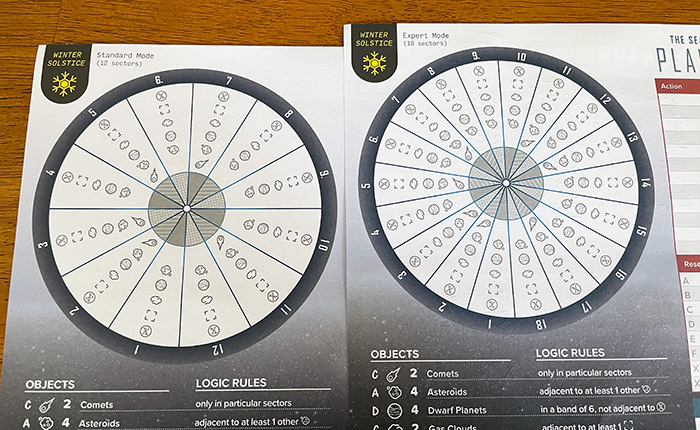
Lastly, I’d like to mention that the game components are great too. The player pawns are shaped like different observatories and the theory tokens are easy to use. The icons for the different objects are clear – even though we joke about them being different things (like calling the comet an ice cream cone and asteroids cookies). And the player screens include the pertinent information for the game as reminders.
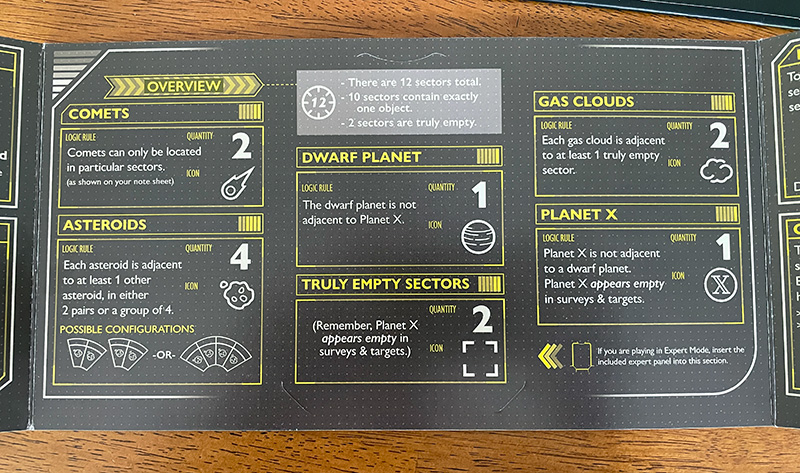
But perhaps the thing we like the most about the game components are the player sheets being oriented for the different sides of the board!
I know that sounds simple, but it’s so, so helpful. Players take a sheet matching the side of the board they’re sitting on so that the layout of the galaxy from their viewpoint is consistent with the board. That way you don’t have to spend any time trying to match up the sectors with your notes. It’s all straightforward because of that attention to detail in the game design. Nicely done!

How does The Search for Planet X score on our “Let’s Play Again” game meter?
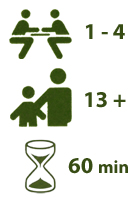 The Search for Planet X scores high on our “let’s play again” game meter – but not in the traditional sense. Because it’s such a “thinky” game, and takes over an hour to play, we haven’t played games back to back.
The Search for Planet X scores high on our “let’s play again” game meter – but not in the traditional sense. Because it’s such a “thinky” game, and takes over an hour to play, we haven’t played games back to back.
Instead, the “let’s play again” is more in terms of wanting to play it again on another night.
In fact, it’s a game I leave out for my monthly friends game night because inevitably there’s someone in the group who will want to play it again next time we meet up. That’s what happened this month as well. Among the group, I heard the familiar call of “I’d really like to play The Search for Planet X again.” So we did.
Overall, The Search for Planet X is a fantastic deduction game. If you enjoy games that make you think, then I’d highly recommend grabbing a copy.
Don’t miss the next awesome game for your family! Subscribe to The Board Game Family reviews and articles.
SUBSCRIBE
As an Amazon Associate, we earn from qualifying purchases from Amazon.com links.


